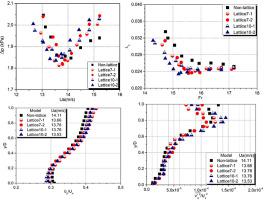Powder Technology ( IF 5.2 ) Pub Date : 2021-09-13 , DOI: 10.1016/j.powtec.2021.09.016 Lin Dong 1 , Yongli Wang 1 , Akira Rinoshika 2, 3

|
This study is focused on reducing the pressure drop, conveying velocity, and power consumption in a horizontal gas–solid flow. Four types of lattice models, which are fixed in the particle inlet, are proposed to easily generate the oscillation of the wake flow to easily convey the gas–solid two-phase flow. A horizontal pipeline with an inner diameter of 80 mm and length of approximately 5 m was used. Polyethylene particles with an average diameter of 2.3 mm and density of 978 kg/m3 were employed as conveying solid materials. The experimental ranges of the average gas velocity and solid mass flow rate were 10–16 m/s and 0.10–0.47 kg/s, respectively. Compared to the nonlattice gas–solid flow, reductions in the total pressure drop, conveying gas velocity, power consumption, and additional pressure loss were achieved in the range of lower gas velocity when using the lattice model. The highest reduction rates of the minimum conveying velocity and additional pressure drop were approximately 5.12% and 15.2%, respectively. In the acceleration region, the particle concentration in the flows with the lattice model was larger than that in the nonlattice flow near the upper part of the pipe and lower than those in the nonlattice flows in the lower part of the pipe. The time-mean axial particle velocity and particle fluctuating velocity in all lattice model flows were higher than those in the nonlattice flow, according to particle image velocimetry measurements, particularly in the upper part of the pipe.
中文翻译:

晶格引起的振荡流对水平气固两相流的影响
本研究的重点是降低水平气固流中的压降、输送速度和功耗。提出了四种固定在颗粒入口的晶格模型,以轻松产生尾流的振荡,从而轻松传达气固两相流。使用内径为 80 mm、长度约为 5 m 的水平管道。平均直径为 2.3 mm,密度为 978 kg/m 3 的聚乙烯颗粒用作输送固体物料。平均气体速度和固体质量流量的实验范围分别为 10-16 m/s 和 0.10-0.47 kg/s。与非晶格气固流动相比,当使用晶格模型时,在较低的气速范围内实现了总压降、输送气体速度、功耗和额外压力损失的降低。最小输送速度和附加压降的最高降低率分别约为 5.12% 和 15.2%。在加速区域,具有晶格模型的流动中的粒子浓度大于管上部附近的非晶格流动中的粒子浓度,而低于管下部的非晶格流动中的粒子浓度。



























 京公网安备 11010802027423号
京公网安备 11010802027423号